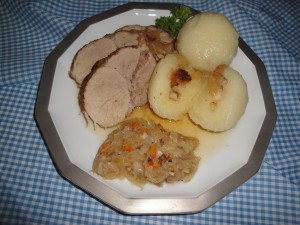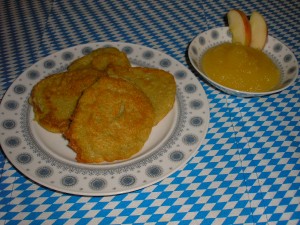The Potato in Bavarian cooking

Potato Flower
Wikipedia states that the original domesticated potato comes from Peru and was introduced by the Spaniards to Europe. I remember hearing that at first the potato plant was regarded in European courts as a flowering ornamental plant and it took some time before they realized that you actually could eat those things growing in the ground.
Just to mention, it seems that the potato came from South America to Europe and than the European settlers supposedly introduced them here in the United States. Heck of a detour, isn’t it?
Back to Europe, local history states that the potato did not reach Bavaria until the year 1647 and what I think is kind of amazing is that the first time they were planted there was in a small village about three miles away from where I was born,but let me tell you, I never knew this bit of trivia while I grew up there.

Potatoes
So now they arrived in Bavaria and “we” planted, grew and harvested them. As they were easy to store for the winter, they became a huge success and were quickly included as part of the local food.
First they were cooked in their skins “Pellkartoffel” (potatoes to peel) then pre-peeled and boiled in water and served as “Salzkartoffel” (Salt potatoes, as you add salt to the water) and once they were left over they were sliced and fried out as “Bratkartoffel” (fried potatoes). As the potato experience continued it seems the French were the one’s to “French Fry” them, this must me true as the German name for these is still the French name “Pommes Frittes”.
Next we mashed them up and served them as “Kartoffelstampf” (mashed potatoes) or added some other ingredients like flour, shaped them and called them “Schupfnudel” or “Schopperle”, in the Italian cooking the Gnocchi would be comparable to these.
The next step was to combine raw and boiled potatoes together to make a dough and form balls out of them calling them “Knödel” (dumplings). Hey, you did not know, that you are getting a free German lesson here, did you? As the consistency of the dumplings had to be a little looser, diced day old white bread was browned in butter and they became the center of the modern Bavarian Potato Dumpling.
Now the evolution did not end here, somebody had too many plums from their trees and decided to “embed” them in the dumplings as, you probably guessed this one, “Pflaumenknödel” (plum dumplings) and sprinkled them with sugar and cinnamon before eating .
Again we had some dumplings left over from our Sunday dinner, so let’s slice them and fry them out with some diced bacon and onions as an excellent side dish for Wieners or Knockwurst the next day.
Now back to the plain old potato, we can bake them, we can mash them, add cheese to scallop them, fry them or wait a minute, we can also make a salad out of them. This way we can even serve them warm or cold.
Melt cheese over them as in the Swiss raclette, grate them for “Röstis” or potato pancakes.
This is only a small sample of what can be done with the “Kartoffel”(potato) or also called “Erdapfel” (earth-apple) in Bavaria, no wonder they became so popular.
As a matter of fact, as they were so cheap to grow they also became a part of the local feed for animals, mainly pigs.
Our Bavarian potato recipes, which include dumplings, potato salad and also potato pancakes are found at




